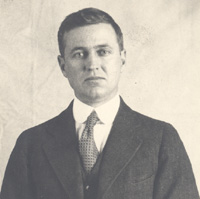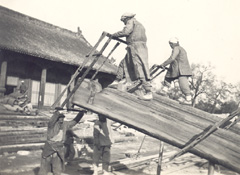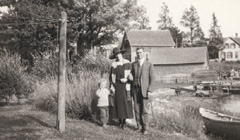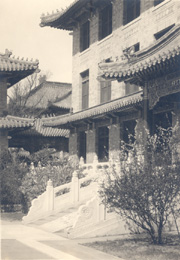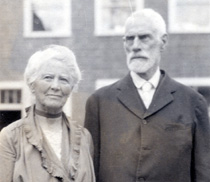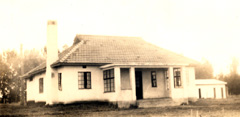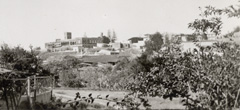A Canadian in the Palaces of the Oil Prince
E.V. Cowdry as a Rockefeller Scientist in China, New York, and Africa
When Washington University reorganized its medical school in the second decade of the twentieth century, endowments for new full-time faculty positions were funded in part by grants from the General Education Board. This philanthropic organization was the earliest of a cluster of agencies established by the Rockefeller family to support research, training, and public health around the world. In 1908 it created the Oriental Education Commission to explore projects in Asia, and later there would be appointments to plan activities in Africa, Latin America, the Caribbean, and U.S. southern states where poverty and disease were endemic. America medical schools meeting Rockefeller standards would serve as models for the overseas projects. The elite international world of “Rockefeller medicine” is the subject of this essay and it is here illustrated by the career of the Canadian-born cytologist and anatomist Edmund Vincent Cowdry (1888-1975), who moved through it with great agility up to the time when he joined Washington University and made St. Louis his home.
The global ambitions were furthered in 1913 when the Rockefeller Foundation was created to oversee all the grant-giving programs of the Rockefeller family. To underwrite its Chinese programs, a new division, the China Medical Board was authorized in 1914. High on its agenda was establishing a school that would introduce American-style medical science to Asia. The China Medical Board chose Peking – today officially known as Beijing – as the focal point of its efforts. The choice was made in part because Beijing was China’s capital, in part also because an existing medical school could be acquired and transformed. That was Union Medical College, founded by a group of British and American churches under the aegis of the London Missionary Society.
Of the many charitable interests maintained by Western nations in China in the early twentieth century, religious missions were the most widespread. In terms of both motivations and methods, the China Medical Board was only a few steps removed from backers of traditional foreign church missions, for it was headed by American Baptist clergymen. In bidding for control of Union Medical College, the China Medical Board pledged to do “all in (its) power to maintain the religious tone and work in the college and hospitals.” When it came to hiring faculty for the reorganized school, John D. Rockefeller, Jr. himself promised “to select only persons of sound sense and high character, who were sympathetic with the missionary spirit and motive.”
Having purchased the Union Medical College, the China Medical Board undertook intensive planning to expand and refurbish the institution. Among the measures was the establishment of a temporary premedical school to prepare initial classes of Chinese students for the admission. It was decided to make English the language of instruction, rather than Chinese, as preferred by most missionary schools. A board of trustees was appointed, followed by the choice of a resident director. For the latter, the China Medical Board turned first to an associated professor of medicine at Washington University, G. Canby Robinson. However, Robinson at the time was deeply involved in organizing the Medical Service of the then new Barnes Hospital and he declined the offer. The position was assumed instead by another promising young physician, Franklin C. McLean, who was a resident at Rockefeller Institute in New York.
McLean made his first inspection of PUMC in the summer of 1916. Work began that year to convert old buildings and construct new ones to form the medical campus. The premedical school was housed in the former Union Medical College building, Lockhart Hall. Adjoining it was an imposing residence which was known as “Prince Yu’s Palace.” This also was purchased by the China Medical Board. Since in Mandarin Chinese the name “Yu” sounds very much like the word for “oil,” and since it was common knowledge who was funding PUMC, the whole campus came to be referred to as the “Oil Prince’s Palace” by the people of Beijing. To expand the complex, construction was underway on the Anatomy Building, the first of several new structures planned for PUMC. When McLean returned to the United States in 1917 he began to recruit new heads of academic departments for PUMC. The first to sign was Cowdry, who was appointed to become professor and head of the Anatomy Department effective in July of that year.
Cowdry, then 29 years of age, was born in Ft. MacLeod, Alberta, and grew up in Waterford Ontario. He was known to family and friends by his middle name, Vincent. His father, Nathaniel Harrington Cowdry, was a banker. His mother, the former Anna Ingham, was from Bermuda – she died when Vincent was an infant and he was raised by his father’s sister Aline Cowdry. During his childhood Vincent spent holidays with maternal relatives on Bermuda and was encouraged to study the marine life of the colony shoreline. He studied biology at the University of Toronto and received his B.A. degree there in 1909. At this point he entered the United States for the first time to begin graduate studies at the University of Chicago. His professors included the eminent endocrinologist Robert R. Bensley and the embryologist Frank R. Lillie, both Canadian-born and University of Toronto alumni. This was a time when knowledge of human anatomy was being reshaped by cellular research outside of medical schools – stripping away many of the limited disciplinary perspectives carried over from nineteenth century clinical teaching. Bensley invited Cowdry and other graduate students to his summer home on the Ontario shore of Lake Huron (“Go Home Bay”). In the laboratory and in the field, the professor demonstrated how zoological research led to applications in human medicine. Cowdry wrote his doctoral work on the nerve cells of selected species of birds, completing his Ph.D. in 1913.
From Chicago Cowdry moved to Baltimore to assume his first faculty position as Associate in Anatomy at Johns Hopkins University. To be called to teach and do research at this paragon of reform-era medical schools was quite a coup for the young Canadian – although a countryman advised “people here don’t like to hear of Canada. So, just keep your mouth shut [on that issue].” Cowdry took the advice and noted “I got along quite well at Hopkins.” Much of his research focused on common features of mitochondria in higher organisms. The functions and means of description of these cytoplasmic organelles was a current subfield and Cowdry became recognized as an expert. Not all work was done in Baltimore, where summers could be unpleasantly hot. At this time he began what became a lifelong association with another summer research venue, the Marine Biological Laboratory of Woods Hole, in southern Cape Cod. The director was Frank Lillie While working there Cowdry met his wife, Alice Hanford Smith, the daughter of a prominent ichthyologist who frequented Woods Hole. They were married in December 1916 and sailed to Cuba on their honeymoon after Christmas.
McLean’s offer the following spring evoked something very akin to the “missionary spirit and motive” needed at PUMC. Cowdry’s initial response was to refuse McLean’s offer out of consideration for his new wife. But Alice immediately assured her husband that she would be able to withstand the rigors of life in the Orient, whereupon he hastily re-contacted McLean to accept the position. Not until a year after the appointment did the Cowdrys leave the United States. In the meantime Cowdry was authorized to recruit other faculty for PUMC – he returned to Chicago to teach a summer course and contacted colleagues from there. Chiefly he recruited for the anatomy department, but also contacted candidates to teach other medical specialties. The process was made difficult by the entry of the United States in World War I. McLean himself was granted a leave of absence to join the American forces in France. Cowdry was for a time the only PUMC professor with a certain commitment to teach in Beijing.
In the summer of 1918 the Cowdrys departed on their long journey westward, over land to San Francisco, then by ship to Shanghai, where they arrived in September. Two varieties of turmoil awaited them in China. Cowdry had been informed that there were outbreaks of pneumonic plague in several provinces and cities, some reported along the rail line linking Shanghai with Beijing. What he was less prepared to encounter was the political and civil disorder then endemic to China. The Cowdrys never encountered the plague on their journey. But they had a very close brush with social chaos when their Beijing-bound train narrowly escaped being attacked by a sizable “bandit” army.
The China which received the Cowdrys had been officially a republic for less than seven years. Before that, various disparate factions throughout the huge nation had struggled against the corrupt last rulers of the Qing (Manchu) Dynasty. Sun Yat-sen was prominent among the leaders who fought for the Republic, but his faction was not strong enough to command allegiance of all China. Indeed, no leader or faction was so strong. Huge districts of the country, whole provinces even, were under the domination of independent warlords. Warlords who lost battles and who were driven from their strongholds could turn instantly into bandit chieftains who preyed alike on poor villages and on trains carrying the wealthy on cross-country voyages.
Another factor to the political disorder in China was the humiliating presence of foreign colonies, concessions, and garrisons on Chinese soil. Newly arrived Americans could be blissfully unaware that, in Chinese eyes, they were lumped together with all other aliens in this regard. Officially, the United States frowned on foreign control of Chinese ports and other strategic areas. American policy was to advocate an “Open Door,” where all outsiders were equal. But the United States put no pressure on the Japanese or British, to name only the most flagrant offenders against Chinese sovereignty, to surrender their colonial enclaves. Instead, the United States joined other powers in maintaining garrisons in China. This imposed a certain stability on the principal cities, whether or not they were under direct foreign control. Beijing, for example, was at once the capital of a country at war with itself, and at the same time a curiously placid political island when the Cowdrys arrived there in the fall of 1918.
A small private house in the quarter of the city where Western business and diplomatic personnel lived was made available to the new arrivals. It was designed by a German architect – and boasted more than the usual conveniences in its electrical system and plumbing. It had an attractive garden and a staff of four servants. Alice was pleased with the residence, assuring her husband that she preferred it to the larger dwellings occupied by other faculty. Not long after their moving in she set about learning Mandarin so to better furnish and provide for the house and to communicate with the staff.
Cowdry recognized certain definite priorities as he began work at PUMC. One was to participate in the organization of the college administration. Another was to oversee the completion of the Anatomy Building and the equipping of its laboratories. Yet another was to conduct further studies on the needs of Chinese medical schools vis-à-vis Western standards. Since medical training at PUMC had not officially started, there were to be no heavy teaching responsibilities during his first years at the college. His own research interests in cytology Cowdry placed last on his list of priorities.
The Medical School proper was one of five divisions of PUMC. Others included the Premedical School, the Nurses Training School, the Hospital and Physical Plant, and the Department of Religious and Social Work. Within the Medical School were academic departments of Anatomy, Physiology (including Pharmacy and Physiological Chemistry), Pathology, Medicine (including Neurology, Psychiatry, and Pediatrics), Obstetrics and Gynecology, Ophthalmology, and Roentgenology.
Throughout 1918 appointments were made which filled the chairs of these departments. But Cowdry, owing to his early arrival on the scene, played an influential role in decisions which affected all of PUMC. For example, he served on a special committee which negotiated the issue of how PUMC employees would be paid. China, with its political chaos, lacked a stable currency and, for various reasons, it was also not possible to pay directly in United States dollars. Instead, portions of salaries paid to the staff while in Beijing were allotted in Mexican silver. The committee recommended and received a pledge from the China Medical Board to maintain a favorable fixed rate of exchange of two dollars Mexican to one dollar U.S. gold.
As work on the Anatomy Building progressed, construction of a new PUMC hospital, the Chemistry Building, and extensions of the residential compounds was initiated. In 1918 over 3,000 workers were employed on the projects. At one point Cowdry invited a Chinese physician to inspect the amazing development of the “Oil Prince’s Place.” The doctor’s reaction was that “Americans always do things the expensive way” – he could not realize just how correct he was. Given wartime inflation and the worldwide scarcity of new technical equipment, the cost of building PUMC ballooned to several times what the Rockefeller Foundation had originally budgeted.
Cowdry took particular interest in building a good medical library. The collection of books and journals was, in his view, “our first requisite.” Even before leaving the United States he prepared lengthy lists of the titles that he wanted. He arrived at PUMC to find a competent librarian already on the job and struggling with a sorely inadequate budget. Cowdry sent urgent letters on the library’s behalf, compiled more lists, and otherwise campaigned hard for the collection. He complained that he was forced to go to Tokyo to find the books he needed. He protested that he was buying books out of his own pocket. This lobbying evidently had some effect, for the China Medical Board did actually quadruple the library budget within a few years. The Rockefeller Foundation could eventually boast that PUMC had the best medical library in all of Asia.
Cowdry was equally energetic in gathering collections of anatomical specimens for use in his department. Shortly upon arriving at PUMC he began sending appeals to foreign sponsored schools throughout China for preserved embryos and fetuses. His choice of contacts was based on the estimation that nothing so sophisticated as a preserved embryo could be obtained from Chinese physicians. But there were disadvantages in writing only to foreigners. More than one response declared, as did a Methodist medical missionary in Fujian Province, that “we are seldom called into (cases involving miscarriage or abortion) for Chinese seem to look on the foreign doctor as a disagreeable necessity to be called in only in the last ditch.” Nevertheless, Cowdry was pleased with the overall results of his appeal. Eventually he also began receiving the cooperation of Chinese physicians. The first such contact was so surprising that the incident proved rather embarrassing. The director of the Chinese Army Medical School in Beijing appeared unannounced one day at the PUMC compound to donate assorted specimens. Cowdry was out at the time. The gatekeeper knew of no one else to call and, in exasperation, ejected the director from the PUMC grounds.
Even more problematic than the acquisition of small specimens was the procurement of cadavers. Only recently dissection had been forbidden under Chinese law and custom. A decree issued by the Republic in 1913 made it legal for the first time, providing permission was given by the relatives of the deceased. This still left bodies almost unavailable for use by foreigners. Cowdry at times resorted to various degrees of subterfuge. A source in Shanghai arranged to pack a cadaver in a crate containing other supplies, with no mention of it on the bill of lading. But a suspicious railway clerk discovered the body anyway and refused the whole shipment. In at least one instance Cowdry enlisted the services of United States Marines to provide him with cadavers. But for all his efforts, only four of this precious commodity reached the anatomy laboratories during Cowdry’s first year and a half in Beijing. Later he established a supply, but under circumstances smacking of the worst American urban graft. It was arranged that bodies of executed criminals might be dissected, providing that the remains be given burials and interred in a special plot of land, with costs borne by the college. The land in question was the personal property of none other than the chief of the Beijing police.
When it came to making long range plans for PUMC, Cowdry, like other Western educators, could not ignore the example that the Japanese set for the rest of Asia. Apart from his intention, already mentioned, to consult libraries in Tokyo, Cowdry wanted to visit Japan to learn something about the qualities of medical education there. Accordingly, he arranged a tour of fifteen Japanese medical schools in the summer of 1919 and described his findings in an article entitled “Anatomy in Japan” (1920). Cowdry was both impressed and disappointed with what he saw. Everywhere he saw modern facilities and dedication to medical science that he considered most laudable. But he also judged that Japanese schools had embraced the worst aspects of what he termed “Prussian philosophy,” an inflexible, highly centralized approach to learning. Cowdry certainly understood that there was little that PUMC could do to diminish the impact of the Japanese system on the Chinese. This was particularly true from 1919 onward when the Japanese consolidated their hold on concessions and interests in China relinquished by the defeated Germans. Cowdry’s objective, simply stated, was to promote understanding and cooperation between Western scientists and their Japanese counterparts.
Following his Japanese survey, Cowdry also undertook study of the teaching of Anatomy at Western sponsored medical schools in China. For this he made an extensive tour of cities up and down the China Sea coast, from Guangzhou (Canton) in the south to Shenyang (Mukden) in the north, in the autumn of 1919. In all, Cowdry visited nineteen institutions and received information by mail about seven more. The only one which refused to divulge any data was a medical school in Qingdao, which the Japanese had seized from the Germans. The survey, with findings published as “Anatomy in China” (1920), found a great variety in teaching methods and facilities. For some institutions, such as the University of Hong Kong, the Japanese Medical School in Shenyang, and the French L’Aurore University Medical School in Shanghai, Cowdry expressed the highest praise. By contrast, he rated some outright “pernicious,” as in the case of the school (unnamed) where anatomy was taught strictly via blackboard drawings, explained not by the instructor but by his native interpreter. Another school admitted plainly that “we don’t teach histology, embryology, comparative anatomy, as our scope is to form practitioners only.”
Worse still, in Cowdry’s view, was the traditional training still being imparted to Chinese practitioners. He made numerous excursions outside the PUMC compound to observe Beijing physicians in their work. He described his experiences in four different articles published in 1920 and 1921. On one occasion he visited the 0ffice of Imperial Physicians, where the deposed Emperor Puyi still received attention. There he was permitted to see the “Golden Mirror,” an official textbook on medicine containing texts compiled over a period of 2,000 years. He was taken to inspect a shrine where a brass statue in human form was kept. The statue was stripped of the robes covering it, revealing a surface punctured by hundreds of tiny holes representing acupuncture positions. Cowdry had no appreciation for the therapeutic value of acupuncture. This visit reinforced what he had concluded from an earlier demonstration of the technique, when he saw a physician “sterilize” his needles by passing them through his hair. Cowdry was also shown two brass mules, male and female respectively: patients were asked to rub the portions of the statues corresponding to the ailing parts of their bodies. Such teachings and practices typified traditional Chinese medicine for Cowdry. He recognized it as part and parcel of the entire system and philosophy of education. This, he reasoned, would have to change radically before modern science could truly take root in China.
There were hopeful signs. The fact that under great pressure, to improve military strength, the Chinese government established new medical schools on Western models for the army and navy was one such indication. Moreover, certain particular events of the time suggested a new receptiveness to Western education. A dramatic example was the attention given the American philosopher and educator John Dewey when he visited China in 1919. Dewey arrived at the peak of his influence as an exponent of liberalized school curriculums in the United States. He began his journey in the Orient with a stay in Japan, where he lectured widely and all the while sent to America a flood of articles on his perceptions of Japanese culture. The Emperor offered him a coveted membership in the “Order of the Rising Sun,” whereupon Dewey created an uproar by refusing, explaining that the order was symbolic of Japan’s undemocratic values.
The Chinese government and the intelligentsia in the principal cities were determined to pay no less homage to Dewey than the Japanese had paid. He was received by Sun Yat-sen in Shanghai and traveled north to Beijing. In the capital he became a visiting professor at the National University, where he lectured on American philosophy and education. The lectures were attended by huge numbers of people and every word that Dewey uttered was translated and reported in the Chinese press. Suddenly, it seemed, every educated Chinese was discussing American concepts of democracy, ethics, and material and scientific progress. Dewey attracted numerous Chinese disciples. The rector of the National University went so far as to hail him as the “Second Confucius.” As he had done in Japan, Dewey reported his impressions of China in American publications. “A Political Upheaval in China,” “Is China a Nation?” “Transforming the Mind of China,” “What Holds China Back?” and “New Culture in China” were but some of the many titles to reach readers back home in the United States.
Cowdry had first been introduced to Dewey at the University of Chicago and now became re-acquainted via the social network of parties and receptions held for foreigners in Beijing. They and their wives became good friends. For Cowdry, Dewey was a kind of godsend. Here was a man who apparently had discovered the correct formula to the immense problem of modernizing China and had the influence to put it to work. “Professor John Dewey of Columbia University,” Cowdry wrote, “is perhaps doing more than any one person to divert the funds squandered by the militarists into educational channels and to lead the mass of people to see themselves as others see them and to assume full responsibility for the orderly development of their only lives.” The key was to give the masses a good stiff dosage of Western style education, at least strong enough to rally public support of the programs of an enlightened leadership. In essence, what Cowdry concluded from his surveys of medical education is what he believed to be true for the larger task of leading China into the modern world. “We cannot change the sentiment of a nation like China overnight, nor yet in fifty year’s time,” he argued, “but a beginning has been made in Peking.”
In retrospect, it is easy to judge such perceptions naive and to recognize that the enthusiasm for Dewey’s teachings which swept China in 1919 and 1920 was a kind of intellectual fad. But to contemporaries, a vision of a Westernized, democratic China could have seemed no more naive or fantastic than another ideal which germinated at about the same time, namely, to transform the country into a Marxist workers’ state on the model of Lenin’s Russia. There were, in fact, many competing formulas imported for the purpose of solving the great Chinese riddle. Dewey wryly observed – and Cowdry valued the observation enough to quote him – “whenever a few (foreigners) are gathered together in China, the favorite indoor sport is ‘saving China.’”
When discussions of politics and philosophy did not satisfy, of course there were other “sports” available for the diversion of the elite foreign residents of Beijing. There were legation receptions, a spring and an autumn horse racing season, a riding stable, bridge clubs, lectures on art appreciation, and Chinese language lessons. Cowdry reported to the Rockefeller Foundation that “our experience is that life in Peking is very much more strenuous from the standpoint of society obligations than life in Washington, D.C.”
In 1919 Cowdry and his wife were joined by his father and his aunt. Cowdry might well have encouraged their coming by writing, as he did to a Canadian friend, “[Beijing] is a very good city to live in, in spite of the cold winter and the heat and dust of the summer. The water supply is first class. The police service as efficient as in any American city and there is no part where it would be unsafe to walk at any time day or night.” The elder Cowdrys quickly adjusted to life in Beijing. Nathaniel Cowdry was an amateur botanist. During his stay he began a scientific study of Chinese medicinal plants, using his son’s laboratory. His work resulted in significant contributions to the literature and a large botanical collection which ultimately was donated to the Department of Pharmacology at PUMC.
Laboratory research, not surprisingly, was the least productive aspect of Edmund V. Cowdry’s experience at PUMC. The completion of the Anatomy Department facilities, his other administrative responsibilities, and the surveys of medical education all retarded his agenda for experiments in cytology. Cowdry was not happy about this. An additional, unforeseen frustration encountered in Beijing was the fact that Alice Cowdry’s health was not good. She suffered from a slow weight loss and other symptoms which the director of the College Hospital himself was unable to diagnose. Cowdry asked for a temporary leave of absence for the summer of 1920, on the grounds of needing to recruit new faculty and to consult with editors of journals to whom he had submitted papers. The Cowdrys told friends and colleagues that they would return in the fall. However, by the time of their journey they knew not only that Alice was still afflicted, but also that she was expecting their first child. The Cowdrys decided in view of these facts that she would remain in the United States.
Cowdry’s contract obligated him to return to Beijing for the 1920-1921 academic year. In the meantime he sought a new position in North America. During much of the summer of 1920 he based his search from the summer residence at Woods Hole. In the security of his research retreat he could resumed his laboratory research while Alice regained her health – her pregnancy appeared unaffected. The Rockefeller Foundation asked Cowdry not to make his intentions to resign from PUMC widely known, for fear it would make recruitment for his successor and other new faculty at the college difficult.
Later on in that same season, Simon Flexner, acting director of the Rockefeller Institute for Medical Research in Manhattan, offered Cowdry a position as an Associate Member (i.e. a principal scientific researcher) which he readily accepted. Cowdry returned to China in November. In January 1921, while he was in Beijing, Alice gave birth to Edmund V., Jr. (“Ned”). The new father received the necessary dispensation to join his family by the following April. Meanwhile, all these comings and goings did not deter Nathaniel Cowdry from staying put at PUMC and continuing his botanical studies – which actually contributed substantially to his son’s understanding of properties of mitochondria shared by plants and animals. The elder Cowdrys remained in China throughout 1920 and most of 1921, when he returned and settled in Baltimore.
Late in his life Cowdry observed in his memoirs – intended as a draft of a publication, but never completed – that PUMC began its decline from the pristine condition and ideas set for it from the moment he left. Others, including faculty whom Cowdry had recruited for the Anatomy Department, remember things differently, that glory days of the Rockefeller institution lay ahead, in the 1920s and 1930s (see for example the essay “Bodies and Bones” about Paul Stevenson, whom Cowdry recruited at PUMC). Whatever the truth on this particular issue, Cowdry was indeed fortunate, for he was moving from one-first class laboratory to another, and this time one located on the mother ship, as it were, where he could return to “pure” research in cytology, with all the comforts of home for himself and family. The Cowdrys rented an apartment on Madison Avenue. Possibly more important was that in Manhattan they were but a few hours journey removed from the beloved Woods Hole, where they bought a summer house (and a cemetery plot – a symbol of permanence if ever there was one).
The first annual report of the Rockefeller Institute issued following Cowdry’s arrival at his new position (April 15, 1922) notes: “. . . an histologist of Dr. Cowdry’s qualifications is not only a valuable adjunct to the general staff, but is capable of extending knowledge within the purposes of the Institute in particular ways.” The report goes on to indicate that a principal focus of his and his colleagues would be Rickettsia, a recently recognized genus of tick-borne bacteria, parasitic in humans and animals and responsible for diseases such as Rocky Mountain spotted fever and varieties of typhus. The objective in this regard for Cowdry and his laboratory associates (notably F.M. Nicholson) was to elucidate how Rickettsia attacked mammalian and insect tissue. To conduct their experiments, Cowdry and Nicholson collected samples of blood-feeding insects and arachnids from different U.S. states and several tropical foreign countries. Some of his sources were rather close at hand: bed lice from Manhattan hotels and hotel suppliers.
From New York Cowdry continued to publish short articles based on his observations of medical science and education in China – over the years he was to continue to meet and work with groups interested in China and to sponsor Chinese scientists in the United States. In terms of his experiences and responsibilities as an educator, Cowdry also devoted thought and planning to publish a grand book-length summation of work up to that time on the structure and functions of the cell. For this he requested notable specialists in the field to submit chapters, among them Lillie, through whom he arranged publication of the book, General Cytology, in early 1924. This was the beginning of an activity, defined in broad terms, bringing scientists together to further a discipline, which Cowdry continued virtually until the end of his life. He enjoyed substantial success and influenced the development of American scientific publication in this regard. His second book of this type was Special Cytology, which appeared in 1928.
Research on Rickettsia set the stage for Cowdry’s next foreign adventure. A colleague who sent an unusual tick species to New York was a South African scientist with ties to Rockefeller Institute, Sir Arnold Theiler, the director of the Onderstepoort Veterinary Station, located near Pretoria. Theiler invited Cowdry to visit his facility to consult on various problems, an expedition for which there was financial support from the Rockefeller Foundation. In May 1924, Cowdry, Alice, and their young son Ned set forth on the long sea voyage to Cape Town and from their journeyed by train across South Africa. At Onderstepoort the family was housed in a bungalow on the Veterinary Station grounds and like in Beijing provided with servants to do the work of the household.
Theiler and the South African government wanted Cowdry to concentrate on determining he causes of two diseases that were devastating herding animals of the region. One was known as jaagseikte (Afrikaans for drive disease) affecting primarily sheep herds. Cowdry first had to take time to investigate a theory Theiler was advancing, namely, that a protozoan parasite was the agent. Once this was proved false, Cowdry traced the real cause to a herpes virus affecting recesses of the animals’ lungs. (He and the great St. Louis surgeon Evarts Graham were later to draw analogies between jaagseikte and forms of lung cancer.)
The other assigned problem was heartwater, affecting cattle and goats as well as sheep among herded animals, and species of antelope and wildebeest among others in the wild. It was a fatal disease posing a substantial threat to the meat exporters of South Africa, recognized in the fever and convulsions of dying animals and the edema of heart and lung tissue detected after slaughter. Cowdry determined initially that the cause was a hitherto unknown species, Rickettsia ruminantium. This nomenclature was in use for two decades until scientists concluded the generic designation was inaccurate and proposed instead Cowdria ruminantium honoring the discoverer and Cowdriosis as the proper technical name for the disease.
At intervals during their eight-month stay in South Africa the Cowdrys visited some of the fabulous gold and diamond mines of Transvaal and enjoyed motor excursions (in a “decrepit Hupmobile”) out to admire natural features of the veldt landscapes. Cowdry’s descriptions of the peoples of the region make plain he never questioned the British-sanctioned racial apartheid and cultural enclaves and superiority of whites over blacks in general.
For their return voyage, the Cowdrys boarded a steamer which took them up the Indian Ocean coast of Africa, through the Red Sea and Suez Canal, and westward across the Mediterranean. They arrived back in the United States in June 1925. In the following months of that year and extending through 1926 Cowdry was busy with the analysis of his accumulated data. There were unexpected collaborations, for example, work with a veterinarian in Montana (Hadleigh Marsh of the Montana Sanitary Livestock Board) to establish the identity of jaagseikte with what was known as Montana progressive pneumonia of sheep. At this time and throughout his career, furthermore, Cowdry varied his attentions in the laboratory. He investigated encephalitis in rabbits. He worked on a system for calculating limitations to cell size with his Institute colleague Pierre Lecompte de Noëy.
In 1927 Cowdry answered a call from another foreign colonial government agency to embark upon a research expedition. This time it was the French government of Tunisia through the Institut Pasteur of Tunis, with funding extended by the Rockefeller Institute. Cowdry’s host was the director in Tunis, the bacteriologist Charles Nicolle, who was famous for his efforts to combat typhus and for discovery of the causes of brucellosis. The Cowdrys sailed to Tunis in March via Algiers. Already well known was the fact that different forms of malaria are caused different species by the protozoan parasite genus Plasmodium, and only a few of them lead to infections in humans. Nicolle believed that dogs might be a reservoir in its cycle and needed Cowdry’s expertise in making a precise cytological analysis of different species of the parasite. Upon arrival in late March, Cowdry set to work gathering samples from dogs in the North Africa capital and animals living in distant desert oases (he himself ventured on such expeditions with French army escorts). Preliminary results of the study held that parasites found in dogs did not cause human malaria. Cowdry worked further in collaboration with a French colleague, Charles Anderson, on a related parasite affecting monkeys.
As always, the Cowdrys traveled and lived in high style on the Tunisian expedition. They stayed in a Swiss-operated Grand Hôtel in the city. Alice shopped for curiosities in the markets, as she had done in acquiring Chinese artifacts to ship home from Beijing. Their return voyage was routed through Paris, since Nicolle insisted that Cowdry stop at the principal facilities of the Institut Pasteur located there, which the latter and Alice were happy to do. They arrived back in New York in early July 1927. During the remainder of the year in his laboratories in Woods Hole and Manhattan Cowdry analyzed his data gathered with Anderson and others. Among his collaborators in New York was a junior colleague newly hired at the Institute, Gordon H. Scott.
Cowdry had accomplished what he had set out do – at least as announced in contemporary publications and in the hindsight of his memoirs – in his sojourns abroad for the Rockefeller Institute. For all that, evidence suggests that at this juncture in his career he felt underappreciated at the Institute. Perhaps it was that he had applied for promotion within its scientific ranks and was told “no.” Untitled notes in Cowdry’s handwriting dated “Feb. 17” [1928?] in his personal files indicate someone told him “your work is good, but isn’t good enough.” They likely transcribe a conversation with Flexner, now the permanent director of the Institute. It was perhaps not a termination notice, because the note continues, “I have all along from the time you first came had in mind that you might make a permanent place for yourself at the Institute . . . You haven’t convinced me yet, but I have confidence that you will.” On the same page is an addendum, dated “Apr. 19,” somewhat more negative in tone: “As a teacher you are excellent but as an investigator you haven’t got the breadth that is necessary at the Institute.”
These conversations unquestionably conveyed motivation to seek a new position. Fortunately for him Cowdry had already received an attractive offer that very spring. Washington University School of Medicine – by that time, such was the school’s updated title – needed a professor of histology. The Department of Anatomy formally encompassed teaching and research in histology, but its long-time chairman, Robert J. Terry, professed little specialized knowledge in this field (he was a gross anatomist and physical anthropologist). In 1924, an autonomous division had been established to entice a distinguished histologist, Stephen W. Ranson, from Northwestern University to work within Anatomy, but to run his own laboratories independent of Terry. Then in 1928 Ranson was lured back to Chicago to become a full department head and director of a research institute.
Cowdry interviewed the dean of the School of Medicine, W. McKim Marriott, in early April and was offered the professorship. His acceptance entailed revising the delicate compromise with Terry. Ranson’s autonomous laboratory would be converted into a Division of Cytology headed by Cowdry, who would have a seat as a full department head on the Executive Faculty board that governed internal affairs of the school. The university met Cowry’s stipulation of a salary raise over what he was earning in New York. There is perhaps no irony to be found that the increase was paid for by a supplemental endowment received from the General Education Board. Cowdry saw to it as well that he could offer Scott a position in the division – the two continued productive collaboration in cytological research in the 1930s.
Cowdry moved with his family in summer 1928 and began his first semester at Washington University in the fall. He leased a house as a temporary residence in the St. Louis suburb of Clayton. Here ended Cowdry’s eleven year employment with the far-flung educational land research enterprises of the Rockefeller Foundation, the “palaces of the Oil Prince.” But his new position afforded him a more secure and suitable stage with which to carry on the programs and contacts developed since his childhood holidays on Bermuda (he was since 1924 a trustee of the Bermuda Biological Station for Research). There were many overseas journeys ahead. On the strength of his work in South Africa, for example, the British Colonial Office commissioned him to investigate another significant disease of cattle, East Coast (or Rhodesian) Fever, in 1930. Cowdry became a U.S. citizen in 1930. He visited Puerto Rico as part of a project to study treatment of Hansen’s disease (leprosy) in 1935. Collaborative writing and editing efforts in the 1930s produced Human Biology and Racial Welfare (1930), Arteriosclerosis (1933), Textbook of Histology (1934, 1938), and Problems of Ageing (1939). Following World War II, Cowdry traveled extensively abroad as an expert on cancer and gerontology. His more old-school departmental colleague Terry observed out of amazement, if not frustration, “Part of his equipment is packing cases.”
The words attributed here to Flexner – “you haven’t got the breadth that is necessary” – were clearly off the mark. Cowdry may have been relatively short in terms of the concentration and constancy of work that is generally an ingredient in stellar bench science and sometimes a factor in achieving its greatest accolades, but breadth he offered by any reasonable definition in abundance.
Related Resources:
Back to Articles

